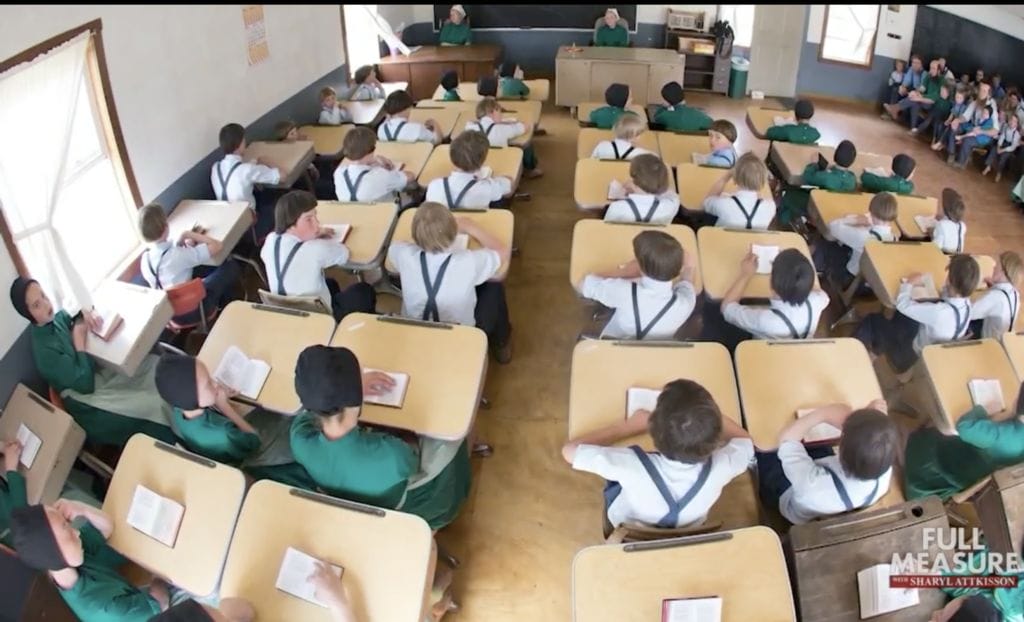The U.S. is said to be more educated than ever before, with one in three Americans getting a college degree. But many are asking, has that really made us any smarter or better equipped to earn a living? Today, we look for lessons to be considered in Pennsylvania Amish Country, where they’re bucking outside trends and often managing to achieve incredible success off no more than an 8th grade education.
The following is a transcript of a report from “Full Measure with Sharyl Attkisson.” Watch the video by clicking the link at the end of the page.
The one-room schoolhouses in Amish Country, here in Lancaster County, Pennsylvania, evoke an era of days gone by.
Sharyl Attkisson: No air conditioning?
Calvin Lapp: Oh, my. None. No plumbing inside. This is the bathrooms out here. No plumbing in here. This is a hand crank water thing for the water there. With the Old Order Amish, eighth grade is it. That’s it. My wife grew up Old Order Amish, so eighth grade was it. My mom grew up Old Order Amish. Eighth grade.
For Amish in this community of 31,000, an eighth grade education is the norm. The less strict, like Calvin Lapp, who is Amish Mennonite, may go as far as high school.
But for all, college is a rarity.
By one recent measure, more than half of recent U.S. college graduates are unemployed or underemployed. So you might assume the young people here, with so little higher education, have an even tougher time earning a living. And yet, they don’t.
Mark Zook is the youngest of nine in an Amish family.
Mark Zook: So here they’re manufacturing a two-story garage.
All the brothers work in the family business building horse barns, sheds, and cabins.
Sharyl Attkisson: What is your position in the company?
Mark Zook: Stoltzfus Structures, I’m a partner. And Horizon Structures, I’d be CEO of Horizon Structures.
Sharyl Attkisson: And how old are you?
Mark Zook: 29.
Sharyl Attkisson: How far through school did you go?
Mark Zook: Eighth grade.
Sharyl Attkisson: How common is it for someone your age, or anywhere over age 20 or so, to not have a job and not have some success at least trying to support themselves?
Mark Zook: In my circle? Zero. I honestly don’t know anyone that is looking for work that doesn’t have work.
Sharyl Attkisson: At a time when many students are exiting college with a degree, giant debt, and no good job prospects, the Amish and Mennonite communities here in Pennsylvania are proving they can generate a lot of success and wealth with no college education at all.
Mark Zook: So growing up in our community, you always work from little up. So in the summertime, when I wasn’t in school, I’d usually be at the shop. That’s pretty normal for our culture and community as a whole. You’re taught work ethic from little up, and you just grow up in it so you don’t really know any better.
Amish and Mennonite Christians came to the U.S. in the 1700s. Their beliefs center on faith, humility, discipline, work, and family. Today, they still live old-fashioned lives, sometimes without modern conveniences like electricity and cars. And though their formal education is limited, it’s hard to look at the rest of the country and not think they’re onto something big here.
In three decades, the cost of college in the U.S. has grown from between $4,000 and $10,000 a year, to $19,000 to $38,000 dollars a year. About 43 million borrowers currently owe $1.6 trillion dollars in federal student loans — on average, approaching $30,000 each.
But at age 30, Shawn Lapp, Calvin’s son, isn’t struggling with college debt or hunting for work. Raised in an Amish-Mennonite household, his formal education stopped after high school. He already had about a decade of work experience under his belt and money in the bank.
He started raising puppies at age 9. And, like most boys here, joined his Dad for work after school.
Shawn Lapp: Well, here I was growing up with dad, like at a really young age, 10, 11, 12 years old. I was pulling the hose around for his landscaping job. As a little boy, I would’ve been, even after school, coming home at three o’clock, dad would pick me up some evenings, and I would help him work for a couple hours. And so just at a really young age, dad taught me that work is important, even at that age, and to learn the discipline right away.
Today, Shawn works with his Dad’s booming lawn care business — 3,000 customers — and is now buying his second house.
Shawn Lapp: So my first house, I was 21, and it was pretty much something that my father had said I should do as soon as I possibly can.
Sharyl Attkisson: Buy the house yourself?
Shawn Lapp: Yeah. My dad had taught me that I need to invest my money for a house. Already at the age of 14, 15, he was talking about it. I had about $50,000 saved up to put down into the house.
Sharyl Attkisson: When you were 21?
Shawn Lapp: When I was 21, yeah.
Stories like Shawn’s aren’t the exception.
Phil Weaver’s dad built a small empire on his 8th grade education.
Phil Weaver: So my dad had, back in the day, maybe 40 cows. He said, “I’m not going to have 40 cows. I’m going to have 200 cows.”
His father’s dreams grew even bigger. He opened this Farm Market in 1970. And through the years, expanded to what’s now known as Shady Maple Plaza, which includes a giant Smorgasbord restaurant and banquet center.
Sharyl Attkisson: On a busy day, how many customers do you have?
Phil Weaver: The biggest day was, I think it’s right around 11,500 people.
Weaver went to high school and then joined his Dad’s business rather than attending college. From a success standpoint, it’s hard to imagine what college would have added. Consider how much these businesses, built on 8th grade educations, are bringing in each year.
Phil Weaver: It’s a 40-plus million dollar business.
Mark Zook: So, combined between the different businesses, 75 to 100 million.
Calvin Lapp: I don’t know if it’s the German drive or if it’s the Amish drive, but we want to sell. I mean, we work hard for it, but we appreciate it. And yeah, they like nice things too. We think, “They drive horses and buggies,” but the horse and buggies are $20,000 for just a horse and buggy. So they’re not much cheaper than a car. And then the land in this area is expensive. So to buy land here that everybody wants, it costs a lot.
Some of the less observant have tested the waters of change. For example, Weaver says that today, high school is a must, and more education is needed for some professions. All four of his kids went to college.
Phil Weaver: At one time, I just thought that my kids probably need to go to college. I very much encouraged them to go. They did pretty good in school. They sort of wanted to go. I thought it was a good thing. Looking back, I’m not sure. There’s just so many jobs, especially in this community, that you can get from plumber to electrician to construction worker, and a lot of different things that you don’t technically need a college education for.
While much of the U.S. grapples with the weight of student debt and unemployment, the formula here remains remarkably simple, rooted in plain traditions followed for hundreds of years. And, so far, relatively undisturbed by modern life knocking at the door.
Shawn Lapp: There’s more of an emphasis on education right now, rather than discipline. And I feel like that’s where we’re going wrong even as a culture or in the U.S. in general. They’re being pushed into education much more than they are being pushed into discipline right away at a young age. And I feel like discipline is going to get anybody more ahead than education will.
Sharyl Attkisson: I think some people view work as a terrible, hard thing you have to do.
Calvin Lapp: It’s not. In fact, my mom said the worst thing about maybe going to heaven is maybe we might not work in heaven. So she’s trying to figure out how she can go to heaven and still be able to work. So, no, we enjoy our work. We won’t do a job unless we enjoy it.
Sharyl (on-camera): Of course, many Americans aren’t so lucky and owe a mountain of student debt.
Watch cover story here.

The Lemonade Mermaid Store
Unique gifts for Land or Sea Mermaids, Mer-pets and Little Mermaids!
Left: Our signature Fish Scales design tote bag in Citrus




I work with several Amish families on a daily basis. Have known them for well over ten years. I can tell you this.. they are all incredibly bright. I have a masters degree and I can’t tell them many things they don’t already know. I met a ten year old Amish boy in upstate NY last week, who shocked me beyond words. It was like speaking to a thirty year old educated man in the body of a ten year old boy. They also understand human nature and are very wise to the wicked ways of this world.
This is all not to mention the quality of their diet, clean lifestyle, strong, faith, and skills that are all too uncommon.
Thanks for showing this interview to the country, as they are admirable people whether one agrees with their way of life or not. I was born in a third-world country and I was the first one in my family to earn an advanced degree, but all of them lived their lives to the fullest, working on all kinds of things, and that’s why your article hit home enough for me to write this. I can imagine leftists tearing their clothes to shreds when they read it, when they are the real unemployables, with their shiny but worthless degrees on all kinds of postmodern “studies.” And who knows, perhaps our American fantasy of a postindustrial world was completely wrong. If you haven’t, please read Joel Kotkin’s recent article on Spiked-online, The revenge of the material economy.
Vladimir Dorta